|
|
|
Sort Order |
|
|
|
Items / Page
|
|
|
|
|
|
|
| Srl | Item |
| 1 |
ID:
097536
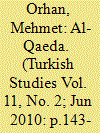

|
|
|
| 2 |
ID:
113532
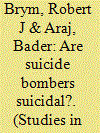

|
|
|
|
|
| Publication |
2012.
|
| Summary/Abstract |
Recent work by Ariel Merari argues that, while certain contextual factors increase the probability of suicide attacks, they do not explain why particular individuals become suicide bombers. Merari seeks to demonstrate that suicide bombers are motivated by an unusually high prevalence of depression and suicidal tendencies. This article questions the representativeness of Merari's sample. It raises the possibility that interviewer and contextual effects contaminated his findings. Finally, it presents evidence that challenges Merari's conclusions. This evidence is drawn from interviews with immediate family members and close friends of a 25 percent random sample of Palestinian suicide bombers who conducted attacks between 2000 and 2005. Based on their analysis, the authors question the value of a psychological approach to the study of suicide bombers and assert the importance of focusing on the political and social roots of the phenomenon.
|
|
|
|
|
|
|
|
|
|
|
|
|
|
|
|
| 3 |
ID:
168220


|
|
|
|
|
| Summary/Abstract |
In recent years, an upward trend in terrorist attacks has mirrored an increase in suicide attacks. According to our preliminary analysis, the events of September 11th marked a sea change in the number of terrorist attacks. While a rich literature has evaluated why terrorists participate in suicide attacks, none have considered the uptick in volume after 9/11, and fewer yet have considered how female fighters may be contributing to this. We evaluate how both structural and female-specific factors affect the likelihood of female fighter suicide attacks. Recent literature discovered a trend in terrorist groups using females as suicide bombers due to cultural norms that permit them to get closer to targets. We test our theory using data from the Chicago Project on Security and Threats Suicide Attack Database (CPOST-SAD) and various datasets from the Quality of Government (QOG) compendium for the 1986–2016 time period. We construct a series of models that consider both female-specific and structural factors that could explain variation in the number of female suicide attacks. Our results indicate that our models encompass relatively stable patterns. Female political empowerment, female educational attainment, and female employment rates are significant and positive in our post-9/11 models, indicating that they may increase female suicide attacks. Democracy is a relevant structural factor and generally yields a positive effect on female suicide attacks across both time periods and multiple models. Ethnic fractionalization is significant in both time periods but yields a negative effect before 9/11 and a positive effect in the later period.
|
|
|
|
|
|
|
|
|
|
|
|
|
|
|
|
| 4 |
ID:
105000


|
|
|
|
|
| Publication |
2011.
|
| Summary/Abstract |
his research on suicide terrorism and arms control focuses on use of the human body as a weapon and the intersection of the body with technology. Through the case of the French terrorist group Action directe (Direct Action) the article analyzes the impact of suicide terrorism on conventional terrorists, the possibility that conventional terrorists become more violent when another group with similar or identical goals turns to suicide terrorism, and asks whether conventional terrorists turn to suicide terrorism once an example is set by another group. The article concludes that contemporary suicide fosters a perception of strength and of the vulnerability of conventional forces. In this light, suicide terrorism and the role that the body plays with an exploding prosthetic, are a major new challenge to how arms control is analyzed and discussed.
|
|
|
|
|
|
|
|
|
|
|
|
|
|
|
|
| 5 |
ID:
132322


|
|
|
|
|
| Publication |
2014.
|
| Summary/Abstract |
The phenomenon of suicide attacks has dramatically expanded over the last twenty years, rising from no events in 1980 to a total of 1,398 events by 2008. A prominent theory has argued that suicide attacks are a coercive strategy aimed at ending foreign military occupation by democracies. Yet these conclusions are based on a research design that is affected by selection bias and that fails to distinguish foreign occupations from cases of groups seeking independence or autonomy, which we term domestic occupations. Analyzing an original data set that distinguishes the different types of occupation, we find that only foreign occupations have a strong and consistent effect on the incidence of suicide attacks. The reason, we argue, is that suicide attacks only become cost effective when targets are both hardened and accessible, a strategic environment that is more common to civil wars and foreign occupations than to domestic occupations.
|
|
|
|
|
|
|
|
|
|
|
|
|
|
|
|
| 6 |
ID:
144083


|
|
|
|
|
| Summary/Abstract |
Suicide attacks continue to plague a multitude of conflict zones. However, the scholarly literature on the phenomenon has yet to produce a theory that explains why militant organizations at different stages of development, facing dissimilar enemies, and situated in unique conflict environments adopt suicide attacks. Moreover, the suicide-attack phenomenon now presents an intriguing puzzle. While most militant organizations fail to achieve their core political ends or ‘outcome goals’, organizations that employ suicide attacks are even less likely to succeed. Still, organizations have adopted suicide attacks at increasing rates. Given their ineffectiveness in precipitating outcome-goal success, why do organizations continue to adopt suicide attacks? Like all organizations, militant organizations share two common aims: (1) to survive and (2) to achieve outcome goals. As martyrdom operations often fulfill the ideological or cultural expectations of certain identity groups, representative organizations may adopt suicide attacks to expand constituent support or enhance status within a particular political landscape. Further, organizations can conduct suicide attacks to signal ideological solidarity with fellow militant organizations. This article analyzes an original large-N dataset of militant organizations alongside an original database of over 5,000 suicide attacks, and evaluates numerous case examples. The results demonstrate that militant organizations across regions and over time have adopted suicide attacks in order to gain supporters, promote organizational longevity, and boost or preserve status.
|
|
|
|
|
|
|
|
|
|
|
|
|
|
|
|
| 7 |
ID:
133508


|
|
|
|
|
| Publication |
2014.
|
| Summary/Abstract |
The study examines the effect of female suicide attacks on foreign media framing of conflicts. Examining the Palestinian-Israeli conflict, 2,731 articles were sampled that covered terrorist events (American, British, and Indian press); 625 appeared in the week following a female's suicide attack, 97 reported an attack by a female perpetrator. The findings suggest that foreign media discourse around female suicide bombers promotes more messages about the society within which the terrorists are embedded. Since the coverage of female terrorists tends to provide more detailed information about the perpetrator, it focuses more on the terror organizations' side of the conflict's story.
|
|
|
|
|
|
|
|
|
|
|
|
|
|
|
|
| 8 |
ID:
090198


|
|
|
|
|
| Publication |
2009.
|
| Summary/Abstract |
Evolutionary theory's utility for the study of political phenomena, including war and nationalism, has been demonstrated. However, these studies fail to explain substate violence, including terrorism, and rarely evaluate whether cost-benefit analyses differ for males and females. This article seeks to demonstrate that evolutionary theory provides intriguing insights into two phenomena that observers find difficult to understand: political violence, including terrorism and self-sacrifice in the form of suicide attacks, and female political violence.
|
|
|
|
|
|
|
|
|
|
|
|
|
|
|
|
| 9 |
ID:
083671
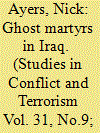

|
|
|
|
|
| Publication |
2008.
|
| Summary/Abstract |
Scholars have developed several rationalist explanations for the use of suicide attacks by terrorist organizations. Using evidence from Palestine, Israel, Lebanon, Sri Lanka, Chechnya, and Turkey, these authors have created plausible and rational models for attacks, which many consider to be "irrational." Although the conflict in Iraq has, by most accounts, experienced more suicide bombings than any other struggle, its contemporary nature has made research and analysis on the subject difficult. This article analyzes four of these models and their implications with respect to the events in Iraq. Although the evidence is not conclusive, the data suggests that organizations are not using suicide attacks to (1) gain nationalist objectives, (2) signal strength to a foreign government, or (3)"outbid" rival organizations, as many scholars suggest. Instead, the evidence suggests that these attacks are used for (1) tactical advantages and (2) to aid the global recruiting effort of Al Qaeda-linked organizations.
|
|
|
|
|
|
|
|
|
|
|
|
|
|
|
|
| 10 |
ID:
109786


|
|
|
|
|
| Publication |
2011.
|
| Summary/Abstract |
Suicide attacks are an important, and effective, terror tactic in Al Qaeda and other Islamist Movements' (AQOIM) tool kit as they wage jihad al saghir (lesser jihad) against the kuffar (infidels). The successful 9/11 terrorist attacks on American soil would not have been possible without the willingness of 19 young Arab men to commit intihar (suicide). AQOIM's "marketing" of suicide attacks in their propaganda campaigns as "martyrdom operations," leads one to ask: Is the use of suicide as a military tactic in war against the kuffar sanctioned in Islam both scripturally and/or by the interpretations/opinions of Muslim scholars and religious figures, as well as by the Muslim public? This article explores the ongoing jihad (struggle) within Islam on what does and does not constitute "martyrdom operations." It does so by exploring the legality of such acts through the lens of Islamic doctrine (Quran and Hadith), as well as studying the interpretations of respected ulema (scholars) on whether or not suicide attacks are indeed "martyrdom operations" to be praised as "halal," or to be condemned as "haram" (forbidden).
|
|
|
|
|
|
|
|
|
|
|
|
|
|
|
|
| 11 |
ID:
119534


|
|
|
| 12 |
ID:
172770


|
|
|
|
|
| Summary/Abstract |
We explore the supply side of the market for suicide attackers. While the strategic edge of suicide attacks for certain terrorist organizations has been thoroughly explored, the motivation of the suppliers remains quite mysterious. We develop a model of the supply of suicide attacks, the motivation of which is expressive but time inconsistent. The model implies terrorist organizations to provide a commitment device in exchange for the ‘services’ of those suicide attackers that do not suffer from any mental or physical burden of life. By contrast, suicide attackers that do suffer from some sufficiently severe burden of life are not reliant on any commitment device and should therefore be expected to more frequently act as lonesome-wolf attackers.
|
|
|
|
|
|
|
|
|
|
|
|
|
|
|
|
| 13 |
ID:
120429


|
|
|
|
|
| Publication |
2013.
|
| Summary/Abstract |
This article examines the contemporary phenomenon of suicide attacks by fusing network analysis and time-series econometrics. We find that a global network of militant organizations drives the reproduction of the suicide-attack phenomenon, and brokers within the network mark the primary perpetrators and diffusers of the tactic. The introduction of a fourth level of analysis of political violence demonstrates that network connections between organizations form a system that perpetuates suicide attacks. An organization-level analysis reveals that ideological congruence facilitates the establishment of network connections. As exemplified by the wide range of employers and targets, and moreover by the generation of an autogamous function, contemporary suicide attacks represent a unique sociopolitical phenomenon. Accordingly, organizations that use the tactic warrant a distinct classification.
|
|
|
|
|
|
|
|
|
|
|
|
|
|
|
|
| 14 |
ID:
106852
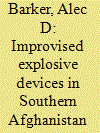

|
|
|
|
|
| Publication |
2011.
|
| Summary/Abstract |
Homemade bombs or improvised explosive devices (IEDs) are staple weapons of conflicts in South Asia and especially Southern Afghanistan and Western Pakistan, where the Taliban, their affiliates, and other armed groups use them to undermine recognized governments and policies. This study establishes IED trends in the Afghanistan provinces of Helmand, Kandahar, and Nimroz and the Pakistani province of Balochistan between 2002 and mid-2009, using geo-referenced open source IED event information and statistical or geospatial analysis techniques. This study also furnishes assessments of specific IED technologies, techniques, and procedures (TTPs; like explosively formed projectiles or radio-controlled "spider devices") as well as discussions of their potential causes and observable effects. There are several major trends observed: a continuous increase in volume and lethality of attacks, more expansive geographic distribution of attacks, and multiple bombing campaigns overlapping in Quetta, Balochistan province, that are perpetrated by groups with different means, tactics, and objectives. The most IED-related violence occurred in Kandahar province from 2002-2008; however, Helmand province was the leading location of bomb events by early 2009. Although large population centers-such as the cities of Kandahar, Quetta, and Lashkar Gah in Helmand province-commonly experienced effective bombings, the trans-border routes through Zaranj in Nimroz province and Spin Boldak in Kandahar province were also prone to many lethal attacks. In particular, this study both confirms and scrutinizes the so-called Iraq effect, the phenomenon of knowledge-sharing between fighters in Iraq and Afghanistan. Even though fighters who gained experience in the Iraq insurgency provided assistance and training to Taliban fighters, the evidence indicates that some developments in IEDs predated the Iraq conflict or were original to South Asia or other conflicts in history. This evidence provides support for a more generalized and global phenomenon here called "TTP acceleration," whereby insurgent and terrorist advances in IED capabilities take progressively shorter periods of time to develop and transfer among groups, usually as a result of increased information-sharing opportunities and coincidental alignment of group objectives.
|
|
|
|
|
|
|
|
|
|
|
|
|
|
|
|
| 15 |
ID:
180202


|
|
|
|
|
| Summary/Abstract |
The University of Chicago Project on Security and Threats presents the updated and expanded Database on Suicide Attacks (DSAT), which now links to Uppsala Conflict Data Program data on armed conflicts and includes a new dataset measuring the alliance and rivalry relationships among militant groups with connections to suicide attack groups. We assess global trends in suicide attacks over four decades, and demonstrate the value of the expanded DSAT with special attention to the growing diffusion of suicide attacks in armed conflicts and the large role of networks established by Al-Qaeda and the Islamic State through 2019 in this diffusion. Overall, the expanded DSAT demonstrates the advantages of integration across datasets of political violence for expanding research on important outcomes, generating new knowledge about the spread of particularly deadly forms of political violence, and raising important new questions about the efficacy of current policies to curb their spread.
|
|
|
|
|
|
|
|
|
|
|
|
|
|
|
|
| 16 |
ID:
094867


|
|
|
|
|
| Publication |
2010.
|
| Summary/Abstract |
Knowledge about the ways in which suicide attacks are recruited and prepared and on the motivation of suicide bombers and the factors that influence the decisions of organizers of suicide attacks has so far been sketchy and sporadic, derived mostly from media sources. In this study, 15 Palestinian would-be suicides and 14 organizers of suicide attacks participated in semi-structured interviews designed to fill this lacuna. The paper focuses on the self-reported feelings and behavior of the suicide bombers from recruitment to dispatching, as well as on the organizers' self-reported views and decisions concerning suicide attacks.
|
|
|
|
|
|
|
|
|
|
|
|
|
|
|
|
| 17 |
ID:
158974


|
|
|
|
|
| Summary/Abstract |
ISIS (the Islamic State of Iraq and Syria) has become a key political and military actor in the Middle East and in North Africa. This essay aims at outlining ISIS warfare through an analysis of its operations in the frame of hybrid warfare theory proposed by Frank Hoffman. Therefore, the paper deals with: the role of terrorist tactics in ISIS warfare and the relationship between terrorism and insurgency; ISIS use of technology, mainly with regard to suicide attacks and to drones; and the relevance of urban warfare. Finally, the paper highlights how ISIS operates and the most threatening features of its warfare.
|
|
|
|
|
|
|
|
|
|
|
|
|
|
|
|
| 18 |
ID:
068914


|
|
|
| 19 |
ID:
169911


|
|
|
|
|
| Summary/Abstract |
This paper provides empirical evidence that suicide attacks systematically draw more media attention than non-suicide terrorist attacks. Analyzing 60,341 terrorist attack days in 189 countries from 1970 to 2012, I introduce a methodology to proxy for the media coverage each one of these attack days receives in the New York Times. Suicide attacks are associated with significantly more coverage. In the most complete regression, one suicide attack produces an additional 0.6 articles—a magnitude equivalent to the effect of 95 terrorism casualties. This link remains robust to including a comprehensive list of potentially confounding factors, fixed effects, and country-specific time trends. The effect is reproduced for alternative print and television outlets (BBC, Reuters, CNN, NBC, CBS), but remains weak for Google Trends (worldwide and in the U.S.), a more direct proxy for people’s interests, and is non-existent for C-SPAN, a television station dedicated to broadcasting political discussions directly. Thus, the media appears to cover suicide missions in an extraordinary fashion, which may in turn explain their prominence among terrorist organizations.
|
|
|
|
|
|
|
|
|
|
|
|
|
|
|
|
| 20 |
ID:
085681
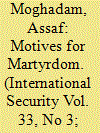

|
|
|
|
|
| Publication |
2009.
|
| Summary/Abstract |
Suicide missions made their modern debut in 1981. In recent years, however, they have witnessed an unprecedented increase according to several indicators, including number of attacks, number of organizations conducting these attacks, number of countries targeted, and number of victims. Existing explanations, including the occupation and outbidding theses, cannot account for the dramatic increase and spread of suicide attacks. A combination of quantitative and qualitative methods, including analysis of a data set of 1,857 suicide attacks from December 1981 through March 2008, suggests that two interrelated factors have contributed to the "globalization of martyrdom": al-Qaida's evolution into a global terrorist actor and the growing appeal of its guiding ideology, Salafi jihad. As localized patterns of suicide missions have given way to more globalized patterns, states must rethink their counterterrorism strategies. At the same time, because Salafi jihadist groups tend to target Muslims, moderate Muslims and nonviolent Salafists must take the lead in challenging these groups.
|
|
|
|
|
|
|
|
|
|
|
|
|
|
|
|
|
|
|
|
|